

Grenzallee is a Berlin U-Bahn station located on the U7.


Grenzallee is a Berlin U-Bahn station located on the U7.
This station was opened in 1930 and built by Alfred Grenander.
A few years later, the Second World War began in 1939, which initially had no direct impact on the station. Only from 1944, the BVG shortened the operation of the line C to Bergstraße, as the tunnel south of the station, including the stations Neukölln and Grenzallee, the arms company Henschel-Flugwerke for monthly 40,000 marks (purchasing power adjusted in today's currency: around 149,200 euros) was made available. However, this foreign use soon became unnecessary due to the ongoing war.
It was the end of the Line CI until 1963. [1]
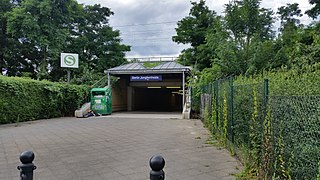
Berlin Jungfernheide is a railway station located at Charlottenburg-Nord, in the Charlottenburg-Wilmersdorf district of Berlin, served by the S-Bahn lines S41 and S42, the U-Bahn line U7 and Regional-Express trains of the Deutsche Bahn. Its name literally translates into "maidens' heathland"; it was named after the Jungfernheide, a former large forest in the proximity of this station.

Augsburger Straße is a Berlin U-Bahn station on the U3 line. It is located in Charlottenburg under Nürnberger Straße where Augsburger Straße crosses it. Station and street are named after the city of Augsburg.
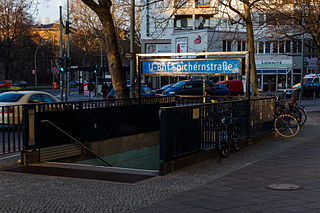
Spichernstraße is a Berlin U-Bahn station located on the U3 and the U9 lines, located in Wilmersdorf neighbourhood. The U3 portion opened on 2 June 1959, replacing the nearby Nürnberger Platz station, which was closed and dismantled. The U9 portion, which lies deeper underground, opened on 28 August 1961 as the southern terminus of the new line, then called G. The eponymous street is named after Spicheren in Lorraine, France, site of the 1870 Battle of Spicheren.

Bayerischer Platz is a Berlin U-Bahn station on the U4 and the U7 lines. The station is located under the square of the same name in the centre of the Bayerisches Viertel neighbourhood in Schöneberg. The U4 station opened with the rest of the line on 1 December 1910 and is now a protected historic landmark; the U7 part of the station opened on 29 January 1971.

Weberwiese is a Berlin U-Bahn station located on the U5 line, which currently runs from Berlin Central Station to Hönow. The station is located under Karl-Marx-Allee directly east of Straße der Pariser Kommune. Although the next station on the line is called Frankfurter Tor, the historical city gate Frankfurter Tor actually stood at the location of the Weberwiese station. Several of the stations on this line have been recently redeveloped and are now colour-coded. In 2003, Weberwiese station was renovated and now has a very different appearance, with yellow tiles in contrast to its former white ones.

Platz der Luftbrücke is a Berlin U-Bahn station located on the U6. It is located under Platz der Luftbrücke and the south end of Mehringdamm on the border between Kreuzberg and Tempelhof, near the former Tempelhof International Airport, and is now named for the square there with its memorial to the victims of the Berlin Airlift.

Paradestraße is a Berlin U-Bahn station on the U6 line. It was opened in 1927 as Flughafen (airport) and at that time provided the world's first direct connection between a metro system and an airport.

Tempelhof is a railway station in the district of Berlin with the same name. It is served by the S-Bahn lines S41, S42, S45 and S46 and the U-Bahn line U6. The S-Bahn station is on an embankment at the junction of Tempelhofer Damm and Bundesautobahn 100, about 1 km south of the entrance to the former Tempelhof Airport. The U-Bahn station, officially called Tempelhof (Südring), is under Tempelhofer Damm immediately south of the S-Bahn station.
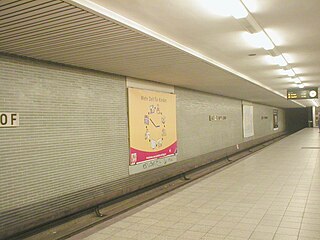
Alt-Tempelhof is a Berlin U-Bahn station on the U6. It is located under Tempelhofer Damm in the centre of the former village of Tempelhof, now a Berlin district within the borough of Tempelhof-Schöneberg. The station opened on 28 February 1966.

Karl-Marx-Straße is a Berlin U-Bahn station located on the U7 line. The station was opened in 1926 as "Bergstraße," and renamed in 1946. Although Karl Marx was a hero of the socialist republic of East Germany, the station is in former West Berlin. In 1968, the station was lengthened to 105m; due to this much of its original appearance was lost. In 1993, parts of the platform fell into the rail track and the station closed for a few days while repairs were made. The station is one stop from Neukölln station, where passengers can transfer to the S-Bahn.
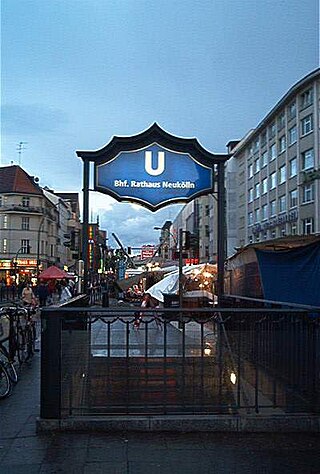
Rathaus Neukölln is a Berlin U-Bahn station located on the U7 line.
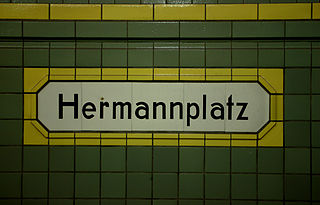
Hermannplatz is a station in the Neukölln district of Berlin which serves as an interchange between the lines U7 and U8. Operated by the BVG, it is one of the busiest stations on the Berlin U-Bahn system.

Bernauer Straße is a Berlin U-Bahn station located on the U8.

Heinrich-Heine-Straße is a Berlin U-Bahn station on the U8, located under the street of the same name in Mitte, and protected as an architectural landmark. The street and the station were called Neanderstraße until 1960.

Boddinstraße is a Berlin U-Bahn station located on the U8. It is located below Hermannstrasse at the intersection of Boddinstrasse in the Neukölln district. The station, opened in 1927, is one of the oldest on the line and is operated by the Berlin Transport Company (BVG) under the abbreviation Bo. The station's name comes from Hermann Boddin, mayor of the community from 1874 to 1907 and later the mayor of Rixdorf, today's district of Neukölln.

Berlin Hermannstraße is a railway station in the Neukölln district of Berlin. It is served by the S-Bahn lines S41, S42, S45, S46 and S47 and the U-Bahn line U8, of which it is the southern terminus. It was formerly also possible to transfer there to the Neukölln-Mittenwalde railway line, which is now only used for goods traffic.

Stralauer Tor was a Berlin U-Bahn station in Berlin-Friedrichshain. It operated between Warschauer Straße and Schlesisches Tor stations on today's U1. Following its destruction in World War II it was never rebuilt and is one of three Berlin U-Bahn stations to have been abandoned after having previously been in service.

Rudow is a locality (Ortsteil) within the Berlin borough (Bezirk) of Neukölln.
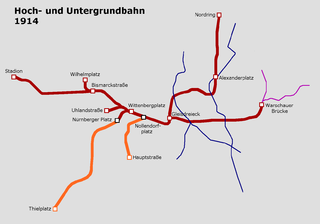
Nürnberger Platz was a Berlin U-Bahn station on what is now the U3, located under the square of the same name in Wilmersdorf on the border with Charlottenburg. The station opened on 12 October 1913 and was permanently closed on 1 June 1959.

The Berlin U-Bahn originated in 1880 with Werner Siemens' idea to build an urban railway in Berlin. During the nine years after the German Empire was founded, the city's population grew by over one-third and traffic problems increased. In 1896, Siemens & Halske began to construct the first stretch of overhead railway. On 1 April 1897, the company began construction of an electric underground railway. The Berliner Verkehrs Aktiengesellschaft (BVG) was formed in 1928, and took over further construction and operation of the network. In 1938, the company was renamed Berlin Transport Company; the original acronym, however, remained. Since 1994, the BVG has been a public company.
| Preceding station | Berlin U-Bahn | Following station | ||
|---|---|---|---|---|
| Neukölln towards Rathaus Spandau | U7 | Blaschkoallee towards Rudow | ||